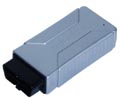- Purge Control Solenoid
- |
- Electrical Actuators
- |
- Repair Basics
- |
- Technical Info
- |
- Car Tech Info
- |
- MicroTronik
Purge Control Solenoid Valve

Purge Control Solenoid Valve

Purge control system
1. Function
A vehicle generates evaporated gas at fuel system such as fuel tank, and HC is the main substance of the gas. Fuel tank requires venting system to avoid pressure rising in the tank when raised temperature generates volume expansion, and there after resulting vacuum pressure. In addition, vapor gas control system is required to prevent fuel vapor from being discharged into atmosphere. Vapor gas control types include crankcase capturing type and activated charcoal capturing type. Activated charcoal capturing type is the most widely used type.
Activated charcoal absorbs fuel vapor very well, and thereafter when blowing air, separates the fuel vapor again. Upon stopping engine, charcoal canister captures vaporized fuel.
During engine running the outside air will blown into the canister separating absorbed fuel out of the charcoal, and route and purge the fuel into intake line.
The Purge control solenoid valve controls vaporized gas which is captured in the canister.
Depending on control signal of the ECU, the valve delivers the gas into intake line or interrupts it.
(1) Line from fuel tank to carbon canister
(2) Carbon canister
(3) Fresh air
(4) Purge control valve
(5) Line to intake manifold
(6) Throttle valve
2. Configuration and Operation Principle
Purge control solenoid valve consists of canister, hose connectors at both ends connected with intake line, ECU terminal. And solenoid and spring located inside.- Purge Control Solenoid Valve controlled by on-off only control type using vacuum pressure of the intake manifold and ECU. The valve will close when coolant temperature is low or engine is idling and open when engine reaches normal operating temperature to deliver vapor gas caught in canister toward intake manifold.
- Purge Control Solenoid Valve controlled by duty controlled type depending on ECU, The valve type that is duty controlled by ECU is particularly called PCSV (purge control solenoid valve), which is controlled by microprocessor using vacuum pressure of the intake manifold, the signal of coolant temperature sensor, etc. Typically the valve closes at 9% duty and wide open at 100% duty.
3. Vaporized Gas Control System Operation
Typically purge control solenoid valve operates at the following condition:- Coolant temperature at approx. 80 degree C or above.
- Operating status other than idling.
- Not learning idle mileage.
There are purge control solenoid valve check method, checking waveform and checking valve condition.
To check the waveform, measure the waveform at the ECM connection line. When the purge control solenoid valve turns on, check whether the voltage becomes close to 0 volt. And check whether voltage becomes the same with the battery voltage when it turns off. If not, check the wiring, fuse and ECM ground condition.
To check the valve condition, check the opening condition and closing condition of the valve using a vacuum pump.
You can check the actuator actual value and status and activate it when it is possible by AutoHex auto Diagnostic Scanner under the supported car brand and according to engine type.
GDS KIA Ecu Flashing using AutoHex II
Description
A vehicle generates evaporated gas at fuel system such as fuel tank, and HC is the main substance of the gas. Fuel tank requires venting system to avoid pressure rising in the tank when raised temperature generates volume expansion, and there after resulting vacuum pressure. In addition, vapor gas control system is required to prevent fuel vapor from being discharged into atmosphere.
Autohex II Reviews
AutoHex II
AutoHex II is your best choice to have full access to dealer functions like coding, adjusting and modules flashing/programming, Contact us for prices
AutoHex Forum


